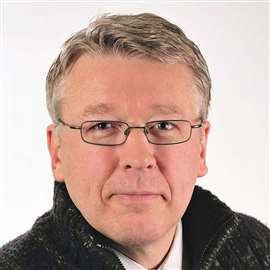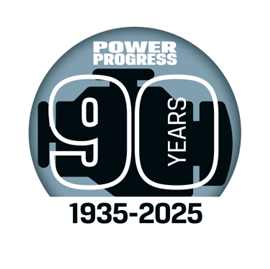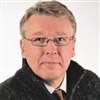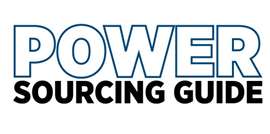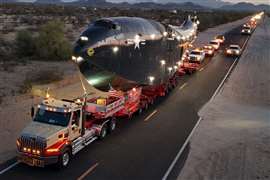Read this article in Français Deutsch Italiano Português Español
Electrification to be front and center for many Bauma exhibitors
05 March 2025
The triennial Bauma trade show, which will begin on April 7 in Munich, Germany, is a massive event, both in terms of visitors and exhibitors. With a focus on construction and mining, Bauma is expected to reveal the latest innovations in finished goods and the components that drive and control them.
Julian Buckley, editor of Power Progress International, attended the Bauma Media Dialogue event at Messe München in February. It allowed the media to preview what exhibitors have in store for the trade show. He said that while Bauma was once dominated by diesel-powered equipment, almost every machine maker will show battery-powered equipment. Others will go further on the leading edge by unveiling hydrogen power — both fuel cells and internal combustion (IC) engines.
Buckley recapped much of what he heard and saw at the Bauma Media Dialogue. Below is a brief selection of some electric component and equipment makers attending Bauma with an overview of what each will present at the trade show next month.
ABB (Hall C2, Stand 413)
ABB has been delivering electric motors for trains, buses and working machines for more than a century. At Bauma 2025, the company will present a series of new products, ranging from the company’s Pro battery range through to the updated AMXE motor series.
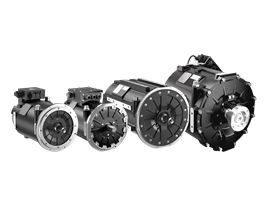 AMXE motors from ABB. (Photo: ABB)
AMXE motors from ABB. (Photo: ABB)
The company stated that as no two applications are the same, it is the capability to develop a specific motor for a given use that can help to deliver the best solution.
Sourced from a range of proven parts, flanges and shafts can be used as standard or customized as required, while torque output and speed can be adapted to suit the vehicle type and duty cycle. Compact designs help to locate the motors onboard the vehicle without sacrificing valuable space.
ABB offers a broad range of traction motors, including the AMXE series, which will feature on the stand at Bauma. These come in a choice of frame sizes, including 132, 160, 200 and 250. All versions can help to reduce carbon dioxide (CO2) emissions while maintaining machine uptime and reducing total cost of ownership.
Schaeffler (Hall A6, Stand 103)
At Bauma 2025, Schaeffler said it plans to highlight how its technology can support planned electrification of construction machinery.
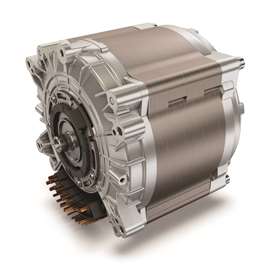 A Schaeffler oil-cooled 800 V heavy-duty electric motor. (Photo: Schaeffler)
A Schaeffler oil-cooled 800 V heavy-duty electric motor. (Photo: Schaeffler)
The company’s electric motor portfolio covers a series of common voltages up to 800 V. Electric drives intended for the construction equipment sector are offered with maximum continuous output of 300 kW.
The drives are said to be “extremely efficient” with a high power density, making them a “key enabler” for the transition to electric drives.
At the Schaeffler stand in Munich, the German power specialist will show electric motors with maximum speeds of up to 10,500 rpm and a continuous power output of 219 kW. Developed specifically for heavy-duty applications, the oil-cooled motors are capable of delivered an efficiency rate greater than 97 percent over a wide range of speeds.
Also on the stand, the company will show its Ewellix liner actuators. These components deliver electromechanical functionality for operations including the opening of flaps and engine hoods. The series covers nominal forces from 1.5 to 150 kN and travel ranges from 300 to 2,000 mm.
Suitable for use with a broad range of heavy machinery, the units deliver a low total cost of ownership due to ‘very long’ maintenance intervals.
Volvo Penta (Hall A4, Stand 412)
Electrification is a key route to helping cut emissions across construction sites and mining operations. At Bauma, Volvo Penta will be showing its latest battery-electric solutions, including its new battery energy storage system (BESS).
 Volvo Penta battery energy storage systems (BESS) support site electrification. (Photo: Volvo Penta)
Volvo Penta battery energy storage systems (BESS) support site electrification. (Photo: Volvo Penta)
The scalable and modular BESS helps to support the integration of battery-electric equipment across work sites. Using the same battery packs as feature in electrified models of Volvo Trucks, Volvo Penta adds the high-power cabling and related battery management system to deliver technology ready-made for final production.
The OEM has taken the route of acting as a supplier of its BESS components due to the inherent flexibility of the tech. Where one unit might feature three battery packs, another could incorporate nine; so dependent on customer need — and the power requirements of the machines — the units can be purposed for specific applications.
“Our modular and scalable battery-electric platform is designed to support the electrification ecosystem, combining high-performance drivelines with the crucial energy storage subsystems for efficient charging,” said Hannes Norrgren, president of Volvo Penta Industrial.
The energy-dense BESS hardware supplied by Volvo Penta can help to deliver power in areas where there is insufficient grid capacity. A favorable C-rating supports both rapid charging and discharging. Also, the BESS can help with peak shaving, reducing draw on the grid to achieve a lower overall energy cost.
Combined with Volvo Penta engines, which support renewable fuels including HVO while offering hydrogen dual-fuel technology, the BESS technology can help to minimize worksite emissions and support future sustainability.
ZQuip (Hall/Stand FN.921/1)
There are some concerns about pure electric machines, largely related to recharging times and the resale value of the machine. ZQuip, as part of Moog Construction, is looking to address these with its swappable machine power system.
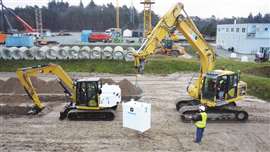 A ZQuip battery pack replacement. (Photo: ZQuip)
A ZQuip battery pack replacement. (Photo: ZQuip)
The ZQuip system includes both battery packs and a diesel engine pack. Dependent on the size of the machine, it can be adapted to accommodate three- or four-pack units. Fitted with all battery packs, the machine uses only electric power. Combining a diesel engine pack and batteries, the machine still uses only electrical power while the diesel engine recharges the batteries.
“ZQuip’s adaptable energy exchange means you can run your machine no matter what energy source the world chooses for construction vehicles,” explained Rob Bauer, engineering manager. “A machine equipped with ZQuip can be emission-free if necessary or run on diesel to extend its working day, much like a hybrid.”
The diesel packs measure 120 x 80 x 110 cm (length, width, height) and have the same dimensions as a 140 kWh battery pack (ZQ140). The battery packs can be switched with fresh units in about five minutes, meaning that there is little time wasted with recharging. Also, as the packs are not integral to the machine, the condition of the pack does not directly affect that of the machine.
At Bauma, Moog will show a ZQuip crawler excavator powered by a ZQ140 battery pack. Other options include a ZQDC quick charger and a ZQuip-AC accessory charger/power supply.
Look for additional Bauma product features in the near future.
POWER SOURCING GUIDE
The trusted reference and buyer’s guide for 83 years
The original “desktop search engine,” guiding nearly 10,000 users in more than 90 countries it is the primary reference for specifications and details on all the components that go into engine systems.
Visit Now
STAY CONNECTED




Receive the information you need when you need it through our world-leading magazines, newsletters and daily briefings.
CONNECT WITH THE TEAM

